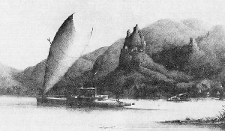Sidestep: Fijian Migrations (a pattern of those to Aotearoa)
- IJ
.jpg/v1/fill/w_320,h_320/file.jpg)
- Jan 8, 2022
- 3 min read
At some stage, about 4000 years ago, a canoe load of adventurous “Lapita” sailors either deliberately set out to the east or were driven off course by a westerly wind and made landfall in the Fijian archipelago. Dr. Green’s theory is that these were the first settlers, not only because at that time they would have had the necessary maritime technology, but also because their pottery is found throughout the whole of Fiji. There is no way of knowing how long they enjoyed Fiji to themselves.
But at some stage the Melanesians followed. It is reasonable to suppose that groups of Melanesians who were in contact with the “Lapita” people in the west would have been quick to take advantage of the better craft used by the “Lapita” seafarers and to incorporate them into their own technology.
It is also reasonable to assume that there may have been only a single successful voyage in each instance. Certainly Fijian legends speak of one canoe and one voyage. The canoe was the Kaunitoni and its people were the settlers. The legend says that the first canoe to touch land on the main island of Viti Levu found an indigenous people. The legend also says that the people of the canoe made their way inland from where they eventually spilled to other parts of Fiji. This is similar to old stories of Polynesians initially moving away from areas the tangata whenua lived... for a time.
We can try to imagine those first years. The canoe arriving, the hostile reception from the established population, the skirmishing and then the long trek into the interior; the build up of population and then the subsequent probing towards the coast for both peaceful and hostile interaction with the indigenous peoples.
“Women and land are the reasons men die”, says an old Maori proverb and there is no reason to suppose it would have been different in pre-historic Fiji. Villages raided, men killed or enslaved and women taken as the prize of victory. Slowly the blood of the distinct ethnic groups would have diffused over both populations, but not to such an extent as to form a homogeneous whole. We can imagine two distinct groups, each modified by the blood of the other but each still retaining its distinct racial characteristics, building up to a series of greater confrontations until finally the descendants of the “Lapita” people are forced out, first into the eastern area of Fiji and then to Tonga and beyond, leaving the dominant Melanesian people in control until many centuries later when once again the descendants of the “Lapita” people, now known as Polynesians, would attempt to return and win back what they had lost.
During this long pre-contact period, Fiji was visited by Tongans who came on regular trading expeditions; Samoans, Wallis Islanders, people of Futuna and Rotuma. At some later stage, not long before European contact, there must also have been contract with Micronesia, most probably Kiribati 1100 miles to the north. The probability of such contact is beyond dispute because the development of the Fijian sailing canoe is so obviously based on the Micronesian model.
The famous English navigator/explorer James Cook notes the difference between the large voyaging canoes he saw in Tonga during his first visit in 1769. During his two subsequent calls he was able to note that the Fijian model had almost completely displaced the indigenous Tongan craft. These show settlement of Fiji to have been achieved some four thousand years ago whereas today most Fijian people trace their descent through some ten generations to the landing of the canoe, the Kaunitoni, and the chiefs Lutunasobasoba and Degei.
The art of pottery brought into the South Pacific by the gifted and versatile “Lapita” people survived in Fiji but failed in Tonga, Samoa and east Polynesia on account of the lack of suitable clay.


















































Comments